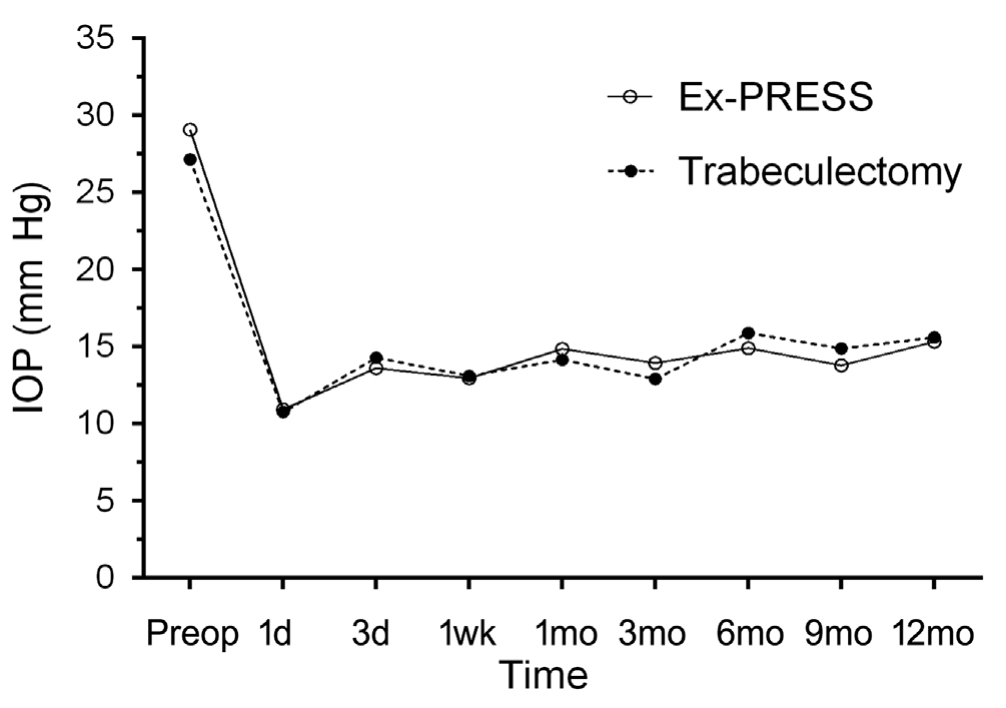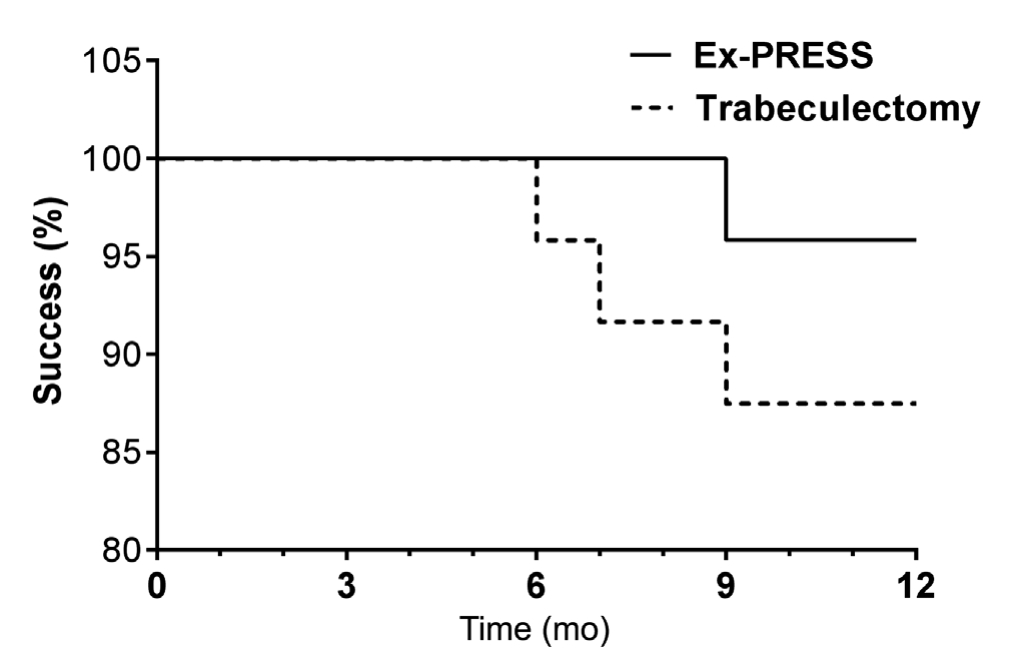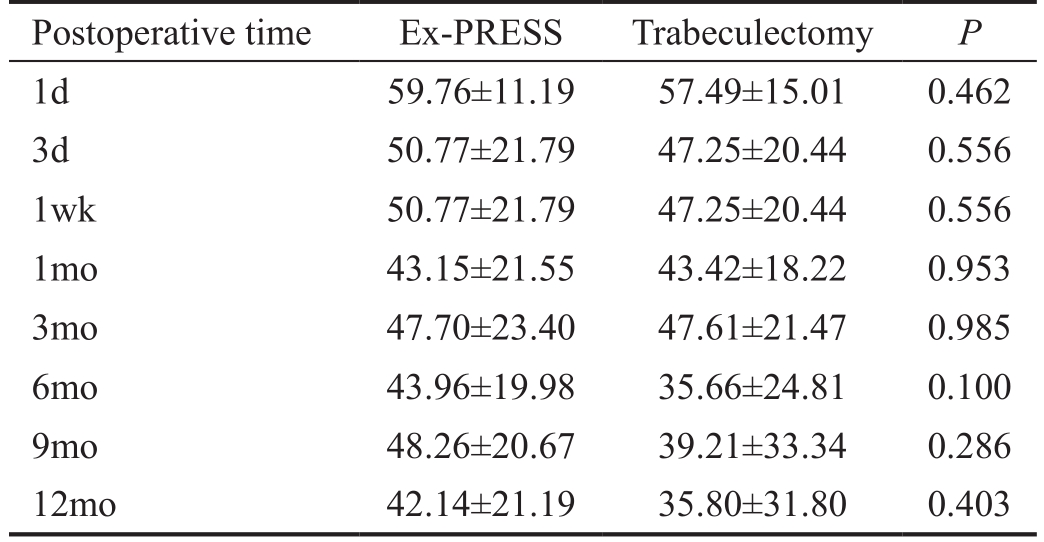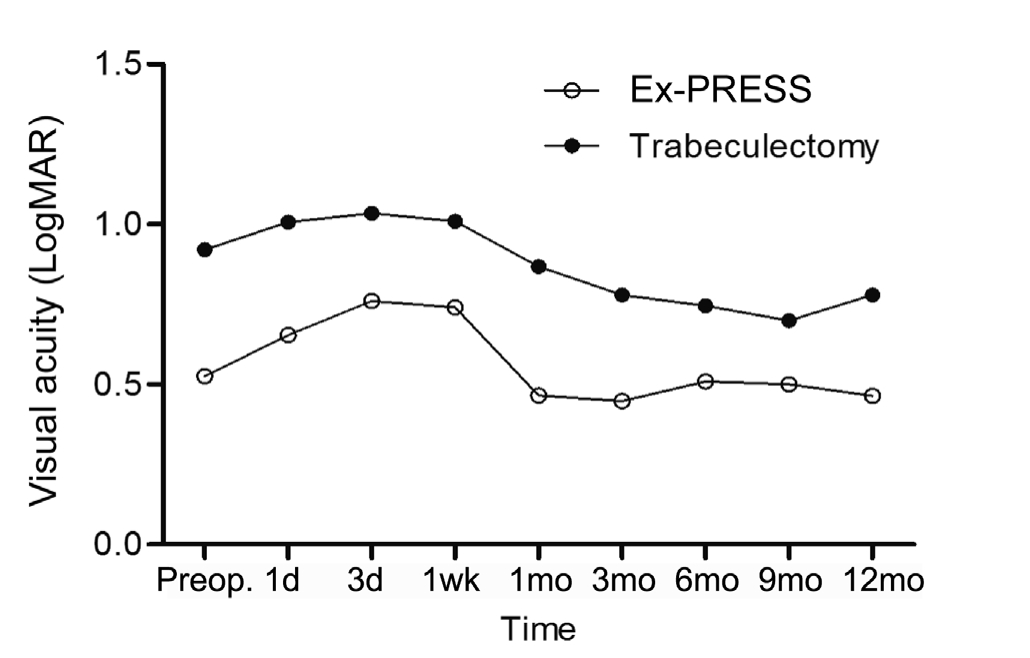INTRODUCTION
Glaucoma is an important cause of blindness worldwide,and approximately 50% of glaucoma patients live in East Asia[1]. Glaucoma leads to progressive optic damage and visual loss in the absence of intervention. Reduction of intraocular pressure (IOP) remains the only effective approach for treating glaucoma. Medication, laser therapy, and surgery have been used for treating primary open-angle glaucoma(POAG). For medically uncontrolled POAG, trabeculectomy is the standard surgical procedure, and it is highly effective in terms of IOP control[2]. However, trabeculectomy may lead to multiple complications such as hyphema, hypotony, choroidal effusion, malignant glaucoma, infection, and cataract progression[3].
The Ex-PRESS device (Alcon Laboratories, USA), a stainless steel tube, is another surgical option for IOP control[4-5]. Initially, the Ex-PRESS device was directly placed under conjunctiva, but this led to a high rate of hypotony and device extrusion.The technique used currently involves changing the implantation under the scleral fl ap. Previous studies suggest that the outcomes of trabeculectomy differ across ethnicities, and East Asian patients have lower surgical success compared to other races and, arguably, higher complication rates[6]. Several studies[7-17] on the efficacy of Ex-PRESS have been published in recent years, but only one study has been conducted in East Asia(Japan) to date[13]. In this small comparative study, Sugiyama et al[13] found that Ex-PRESS implantation resulted in similar IOP, higher success rate, and fewer complications in comparison with trabeculectomy over 12mo.
The Ex-PRESS device was approved by the Chinese Food and Drug Administration approval in 2012 and is used widely in China. To our knowledge, there are no reports of postoperative outcomes in Chinese patients. This study aimed to report the one-year results of Ex-PRESS versus trabeculectomy in Chinese patients with bilateral POAG only.
SUBJECTS AND METHODS
Ethics Statement This prospective non-randomized comparative study was approved by the Ethical Review Committee of Zhongshan Ophthalmic Center, and it was performed in accordance with the tenets of the Helsinki Declaration. Ethical approval for this study (Ethical Committee NO.2013MEKY022) was provided by the Ethical Committee of Zhongshan Ophthalmic Center, Guangzhou, China on 20 November 2013.All patients were recruited consecutively from Zhongshan Ophthalmic Center, and they singed informed consent before participating in the study.
Subjects The inclusion criteria were as follows: 1) ≥18y old;2) presented with bilateral POAG; 3) glaucoma progression or uncontrolled IOP under maximally tolerated medical therapy;4) clear lens or mild lens opacification without indications for cataract surgery. We excluded patients with other ophthalmic diseases, history of ocular surgery, other types of glaucoma such as angle-closure glaucoma, pseudoexfoliation glaucoma,pigmentary glaucoma, uveitis glaucoma, and glaucoma secondary to ocular trauma and angle recession. Because of the actual conditions in China, the decision to undergo a procedure in this study was made by the patients. Thefirst surgical eye of each patient was allocated to the Ex-PRESS group or the trabeculectomy group based on patient’s preference, and the second eye was allocated to the other surgery group. One surgeon(Zhang XL) performed all surgeries.
Surgical Techniques All the patients underwent Ex-PRESS implantation or trabeculectomy alone, and none of them received combined surgeries such as combination of Ex-PRESS and cataract extraction. All surgeries were performed under standardized protocols for both procedures[18-20]. Under topical anaesthesia, a limbus-based conjunctival flap was dissected,followed by the production of a “4×4 mm × half scleral thickness” scleral fl ap. Maintenance or restoration of anterior chamber was achieved using a balanced salt solution. Mitomycin C was placed under the scleral fl ap (0.4 mg/mL, 1-2min) and washed by balanced salt solution in all eyes. When mitomycin C was used in thefirst eye, the length of time for which a patient received mitomycin C at the time of surgery depended on the risk of surgery failure determined by the surgeon (risk factors include younger age and eyes with thicker Tenon’s layers).When the second fellow eye underwent surgery, the exposure time of mitomycin C was the same as that for thefirst eye.
For the Ex-PRESS group, a P50 Ex-PRESS device was used.It was inserted into the anterior chamber with the help of a 25-gauge needle and delivery system. For trabeculectomy, a 1.5×1 mm sclerectomy and peripheral iridectomy was created.Sutures of scleral and conjunctival flaps were identical for both procedures. Postoperatively, all eyes were treated with the same medication (diclofenac 0.1% × 3 daily) for 8wk. If pressures were <5 mm Hg or in the presence of a shallow anterior chamber during the first week postoperatively, tropicamide 0.5% was added 4 times daily.
Outcome Measurements Patients were evaluated postoperatively on 1 and 7d in 1, 3, 6, 9 and 12mo. The primary outcome measures were IOP and success rate. Secondary outcome measures included aqueous flare, postoperative medication,best-corrected visual acuity, and incidence of adverse events.The incidence of aqueous flare was evaluated using a laser fl are meter (Kowa FM-500, Japan). Flare intensity and fl are values were recorded over 3mo postoperatively. All follow-up evaluations were recorded by one observer. IOP ≥5 mm Hg and ≤21 mm Hg without further surgical intervention was defi ned as surgical success.
Statistical Analysis All statistical analyses were performed using SPSS version 20.0 (SPSS Inc., Chicago, IL, USA). Under a significance level of 0.05 and with a power of 0.85, it was estimated that 12 pairs of eyes were needed, according to a previous study[10]. For comparisons of the two groups, the 2-paired t-test was used for normally continuous variables,Fisher’s exact test was used for categorical variables. Repeated mixed analysis of variance was used to analyze IOP profiles.Kaplan-Meier analysis was used to analyze success rates in both groups. P<0.05 was accepted as statistically significant.
RESULTS
This study included 48 eyes of 24 patients, 14 males and 10 females. The mean age of the patients was 41.38±16.52y. In each patient, both eyes had similar glaucoma severity before operation, with a mean cup-disk ratio ≥0.80 in both groups.No significant differences in demographical and clinical parameters were noted between the Ex-PRESS group and the trabeculectomy group (all P>0.05), including visual acuity,IOP, visualfield, or medications used (Table 1). The mean time interval between thefirst eye and the second eye was 2d (1 to 3d) in both groups. All 24 patients received follow-up examinations for 1y after surgery. All available data for these patients are included in the analyses.
Figure 1 shows the IOP profiles of both groups. The IOP 12mo after operation was 15.29±3.72 mm Hg in the Ex-PRESS group and 15.58±4.73 mm Hg in the trabeculectomy group(P=0.811). There were no significant differences between both groups at any point in time. Both groups had similar IOP changes from baseline, ranging from 42.14% to 59.76% in the Ex-PRESS group and from 35.66% to 57.49% in the trabeculectomy group (Table 2).
Figure 2 shows the survival curves of the Ex-PRESS and the trabeculectomy groups. According to the definition of success in this study, the success rates of Ex-PRESS and trabeculectomy were 100% and 95.8% at 6mo, and 95.8% and 87.5%at 12mo with no statistically significant differences (P=0.289,log-rank test).
The mean aqueous fl are values increased significantly on 1 and 3d, and in 1wk compared to the preoperative values (all P<0.05), with a peak on 1d and return to pre-operative levels in 2wk. Aqueous fl are on 1 and 3d after surgery was lower in the Ex-PRESS group than that in the trabeculectomy group(both P<0.05). The number of antiglaucoma drugs used decreased from 3.14±0.63 to 0.4±0.8 at 12mo in the Ex-PRESS group and from 3.20±0.61 to 0.5±1.0 in the trabeculectomy group. No significant differences in visual acuity between the two groups were detected at all points in time (Figure 3).
Table 1 Demographic and baseline examination variables

IOP: Intraocular pressure; SD: Standard deviation; BCVA: Best corrected visual acuity.

Figure 1 Mean IOP after implantation of Ex-PRESS under scleral fl ap and trabeculectomy.

Figure 2 Kaplan–Meier survival curve with success defined as 5≤IOP ≤21 mm Hg with or without glaucoma medication The success rate was 95.8% (Ex-PRESS Group) and 87.5% (Trabeculectomy Group) at one year postoperatively (P=0.289, log-rank test).
Table 2 Percentage reduction in IOP over time after Ex-PRESS under scleral fl ap and trabeculectomy  ±s
±s

Percentage reduction in IOP is defi ned as the reduction in IOP compared to preoperative IOP.
Table 3 summarizes the postoperative complications in both groups. Trabeculectomy was associated with more complications than Ex-PRESS implantations (37.5% vs 8.3%; P=0.036).Hypotony was observed more frequently after trabeculectomy than after Ex-PRESS implantation (33.3% vs 4.2%). One eye in the Ex-PRESS group (4.2%) and seven eyes in the trabeculectomy group (29.2%) experienced choroidal effusions.Furthermore, one trabeculectomy eye underwent hyphema.During the follow-up of 12mo, cataract formation/progression was noted in 2 (8.3%) of the Ex-PRESS group compared to 3(12.5%) of the trabeculectomy group (P=0.637). However, the cataract in these patients did not affect the vision severely.
DISCUSSION
Ex-PRESS implantation is a new surgical option for treating glaucoma[19,21-22]. Currently, three models (X, P and R) and the corresponding needles for insertion (23-, 25-, and 27-gauge)are available in clinical practice. Although similar to standard trabeculectomy in many ways, Ex-PRESS implantation does not need sclerectomy and iridectomy[5].

Figure 3 Visual acuity (logMAR) after implantation of Ex-PRESS under scleral fl ap and trabeculectomy The mean visual acuity was stable and no significant change from baseline was observed in both groups (all P>0.05). During the follow-up period, there were no signi ficant differences between the two groups at all points in time.
Table 3 Postoperative complications n (%)

As far as we know, this paper is the first report on surgical outcomes of Ex-PRESS in Chinese POAG patients. Consistent with previous studies in Western participants, this study confirmed that Ex-PRESS led to similar IOP, change from baseline IOP, success rates, medicine use, and visual acuity as trabeculectomy[8-12,14-15,17]. The results were also in agreement with the recent Meta-analysis, which showed that Ex-PRESS has equivalent efficacy and lower frequency of complications than trabeculectomy[23-24]. Instead of afistula of variable size, Ex-PRESS drains aqueous humour through a tube of consistent size.Thus, the out fl ow in Ex-PRESS may be more controlled and predictable compared with that in traditional trabeculectomy.
Most surgeons have greater experience performing trabeculectomy than Ex-PRESS implantation because the latter technique was introduced more recently. In this study, all surgeries were performed by an experienced surgeon (Zhang XL). In a longer follow-up study, de Jong et al[14] showed that Ex-PRESS was associated with better efficacy than trabeculectomy. Therefore, as surgeons’ become more experienced in performing Ex-PRESS implantation, more favourable results may be achieved by Ex-PRESS.
Besides assessing the IOP-lowering efficacy of Ex-PRESS,one of the important purposes of our study was to determine objectively whether anterior chamber in fl ammation after Ex-PRESS was different from that after trabeculectomy. To our knowledge, no reports on this topic have been published thus far. Our results showed that anterior chamber inflammation was significantly lower in the Ex-PRESS group than in the trabeculectomy group during the initial 2wk after surgery. This may be because of the omission of sclerostomy and iridectomy in Ex-PRESS[4]. In rabbits, it has been shown that levels of TGF-β2 were lower in the Ex-PRESS group than in the sclerostomyfiltration surgery group[25].
In this study, too, we found low rates of choroidal effusions,hypotony, and hyphema after Ex-PRESS compared with those after trabeculectomy. Thesefindings are consistent with those of previous studies. Maris et al[17] found that Ex-PRESS was associated with lower frequency of hypotony (4% vs 32%) and choroidal detachment (8% vs 38%). The reduced frequency of hypotony may be ascribed to additional resistance to flow through the 50-μm lumen of the shunt[23]. The lower likelihood of hyphema in the Ex-PRESS group could be attributed to the fact that iridectomy was not required in the Ex-PRESS procedure.
Ethnicity was associated with the outcomes of glaucoma filtration surgery, and East Asian eyes may have poorer response to surgery compared to those of other races. Currently, most available data on Ex-PRESS have been recorded in white and black populations, and only one study was conducted in Asia(Japan) [13]. However, that study included only 21 eyes (10 Ex-PRESS eyes, 11 trabeculectomy eyes), and the sample size was inadequate for detecting any significant difference between treatment regimes. In addition, that study also included secondary glaucoma patients and patients with previous surgical history, which may have introduced selection bias. In our study, a single observer followed all patients closely. Thus, the quality of evaluation and data were consistent throughout the follow-up. Only eyes with advanced bilateral POAG and presenting uniform, homogeneous characteristics were included in this study. In addition, the study was strengthened by the use of the inter-eye comparison model. We determined objectively the in fl ammation produced after both procedures.
Our study has several weaknesses. First, the treatment decision was not assigned by randomized design. However, we took every possible step to reduce potential bias and analysed thefinal data discreetly. The main purpose of randomization was to ensure that the baseline characteristics were comparable between groups. In this study, the baseline features in the Ex-PRESS group and the trabeculectomy group were similar, although non-randomization was adopted. Second, the one-year duration is relatively short. The long-term outcomes of using the Ex-PRESS device to treat POAG need to be determined.Third, only one centre and one surgeon were involved in this study. This limited the generality of thefindings to other populations. Fourth, the masked technique was not used in the evaluation process, which may have introduced classification bias into the study. Finally, the modest sample may have produced potential bias. Additional large and multiple-centre studies are warranted.
In conclusion, Ex-PRESS implantation showed efficacy similar to that of trabeculectomy in the studied POAG population of Chinese ethnicity, including in terms of IOP, success rate, glaucoma medication, and visual acuity. Meanwhile, Ex-PRESS led to fewer occurrences of in fl ammation and a lower rate of complications. Furthermore, large multiple-centre randomized trials with longer follow-up periods are needed to confirm or refute thefindings.
REFERENCES
1 Quigley HA, Broman AT. The number of people with glaucoma worldwide in 2010 and 2020. Br J Ophthalmol 2006;90(3):262-267.
2 Sun LL, Lee GA. Trabeculectomy: the limitations for registrar training.Clin Experiment Ophthalmol 2013;41(2):135-139.
3 Razeghinejad MR, Fudemberg SJ, Spaeth GL. The changing conceptual basis of trabeculectomy: a review of past and current surgical techniques.Surv Ophthalmol 2012;57(1):1-25.
4 Salim S. The role of the Ex-PRESS glaucomafiltration device in glaucoma surgery. Semin Ophthalmol 2013;28(3):180-184.
5 Buys YM. Trabeculectomy with ExPRESS: weighing the benefits and cost. Curr Opin Ophthalmol 2013;24(2):111-118.
6 Husain R, Clarke JC, Seah SK, Khaw PT. A review of trabeculectomy in East Asian people--the in fl uence of race. Eye (Lond) 2005;19(3):243-252.
7 Moisseiev E, Zunz E, Tzur R, Kurtz S, Shemesh G. Standard Trabeculectomy and Ex-PRESS Miniature Glaucoma Shunt: A Comparative Study and Literature Review. J Glaucoma 2015;24(6):410-416.
8 Beltran-Agullo L, Trope GE, Jin Y, Wagschal LD, Jinapriya D, Buys YM. Comparison of visual recovery followingex-PRESS versus trabeculectomy: results of a prospective randomized controlled trial. J Glaucoma 2015;24(3):181-186.
9 Netland PA, Sarkisian SR Jr, Moster MR, Ahmed II, Condon G, Salim S, Sherwood MB, Siegfried CJ. Randomized, prospective, comparative trial of EX-PRESS glaucoma filtration device versus trabeculectomy(XVT study). Am J Ophthalmol 2014;157(2):433-440.e3.
10 Dahan E, Ben Simon GJ, Lafuma A. Comparison of trabeculectomy and Ex-PRESS implantation in fellow eyes of the same patient: a prospective, randomised study. Eye (Lond) 2012;26(5):703-710.
11 Seider MI, Rofagha S, Lin SC, Stamper RL. Resident-performed Ex-PRESS shunt implantation versus trabeculectomy. J Glaucoma 2012;21(7):469-474.
12 Marzette L, Herndon LW. A comparison of the Ex-PRESS™ mini glaucoma shunt with standard trabeculectomy in the surgical treatment of glaucoma. Ophthalmic Surg Lasers Imaging 2011;42(6):453-459.
13 Sugiyama T, Shibata M, Kojima S, Ueki M, Ikeda T. Thefirst report on intermediate-term outcome of Ex-PRESS glaucoma filtration device implanted under scleral fl ap in Japanese patients. Clin Ophthalmol 2011;5:1063-1066.
14 de Jong L, Lafuma A, Aguadé AS, Berdeaux G. Five-year extension of a clinical trial comparing the EX-PRESS glaucoma filtration device and trabeculectomy in primary open-angle glaucoma. Clin Ophthalmol 2011;5:527-533.
15 Good TJ, Kahook MY. Assessment of bleb morphologic features and postoperative outcomes after Ex-PRESS drainage device implantation versus trabeculectomy. Am J Ophthalmol 2011;151(3):507-513.
16 Gallego-Pinazo R, López-Sánchez E, Marín-Montiel J. Postoperative outcomes after combined glaucoma surgery. Comparison of ex-press miniature implant with standard trabeculectomy. Arch Soc Esp Oftalmol 2009;84(6):293-297.
17 Maris PJ Jr, Ishida K, Netland PA. Comparison of trabeculectomy with Ex-PRESS miniature glaucoma device implanted under scleral flap. J Glaucoma 2007;16(1):14-19.
18 Sarkisian SR Jr. The Ex-PRESS miniature glaucoma device and the glaucoma surgery treatment algorithm. Clin Experiment Ophthalmol 2011;39(5):381-382.
19 Francis BA, Singh K, Lin SC, Hodapp E, Jampel HD, Samples JR,Smith SD. Novel glaucoma procedures: a report by the American Academy of Ophthalmology. Ophthalmology 2011;118(7):1466-1480.
20 Hendrick AM, Kahook MY. Ex-PRESS mini glaucoma shunt: surgical technique and review of clinical experience. Expert Rev Med Devices 2008;5(6):673-677.
21 Salim S. Current variations of glaucomafiltration surgery. Curr Opin Ophthalmol 2012;23(2):89-95.
22 Dahan E, Carmichael TR. Implantation of a miniature glaucoma device under a scleral fl ap. J Glaucoma 2005;14(2):98-102.
23 Wang W, Zhou M, Huang W, Zhang X. Ex-PRESS implantation versus trabeculectomy in uncontrolled glaucoma: a meta-analysis. PLoS One 2013;8(5):e63591.
24 Wang W, Zhang X. Meta-analysis of randomized controlled trials comparing EX-PRESS implantation with trabeculectomy for open-angle glaucoma. PLoS One 2014;9(6):e100578.
25 Nyska A, Glovinsky Y, Belkin M, Epstein Y. Biocompatibility of the Ex-PRESS miniature glaucoma drainage implant. J Glaucoma 2003;12(3):275-280.